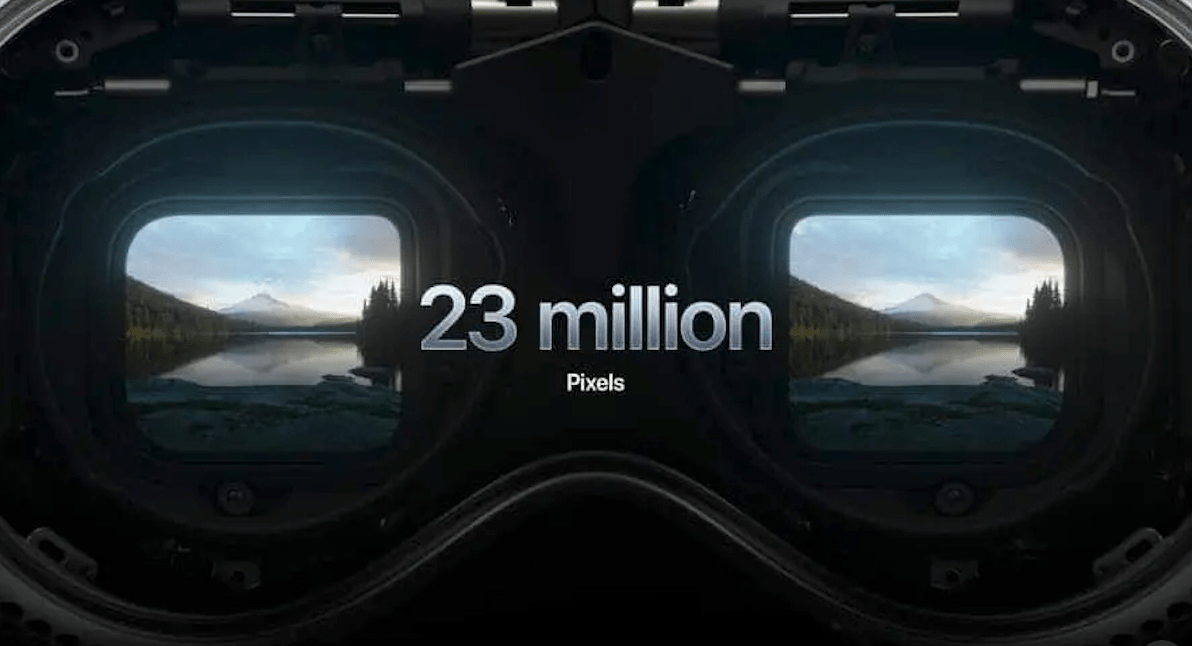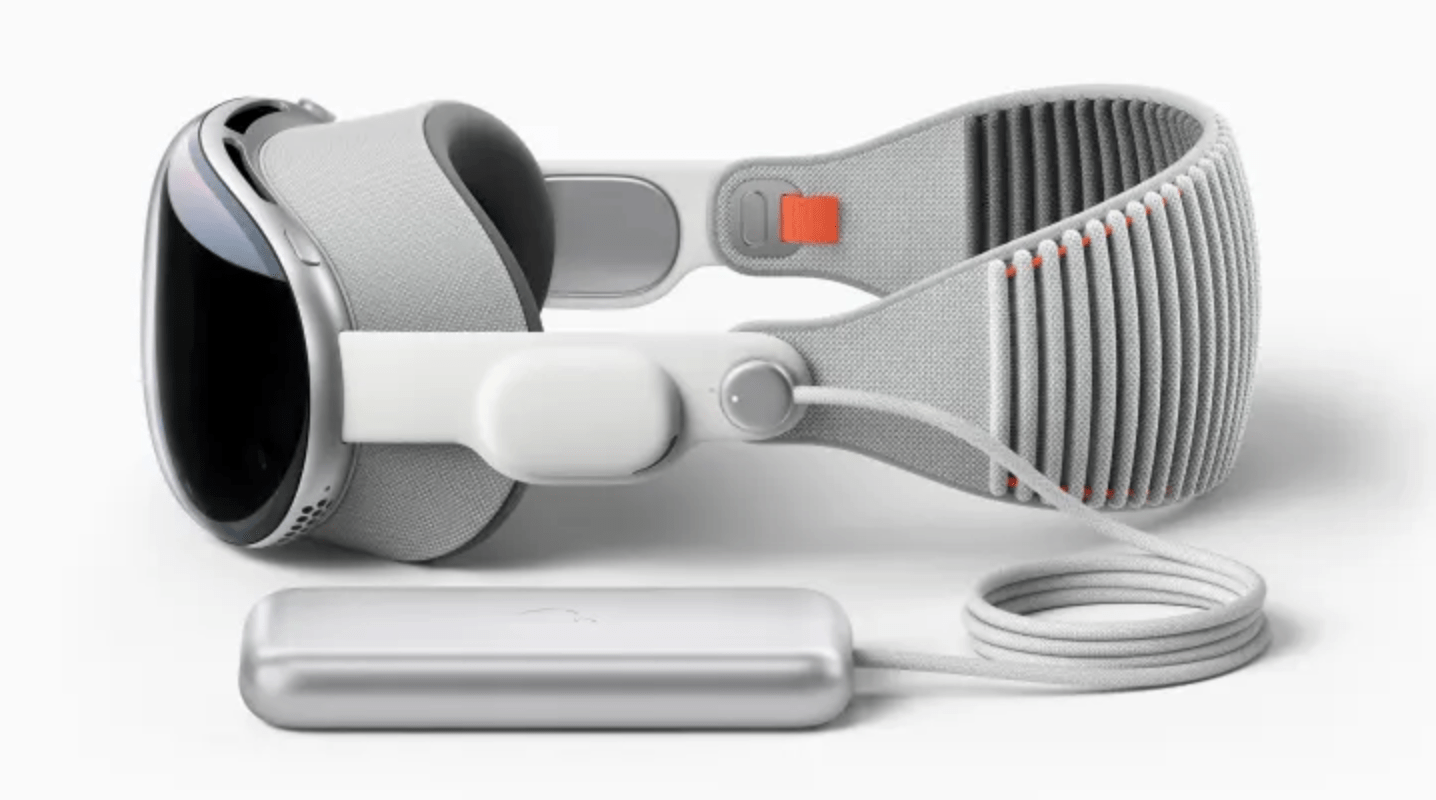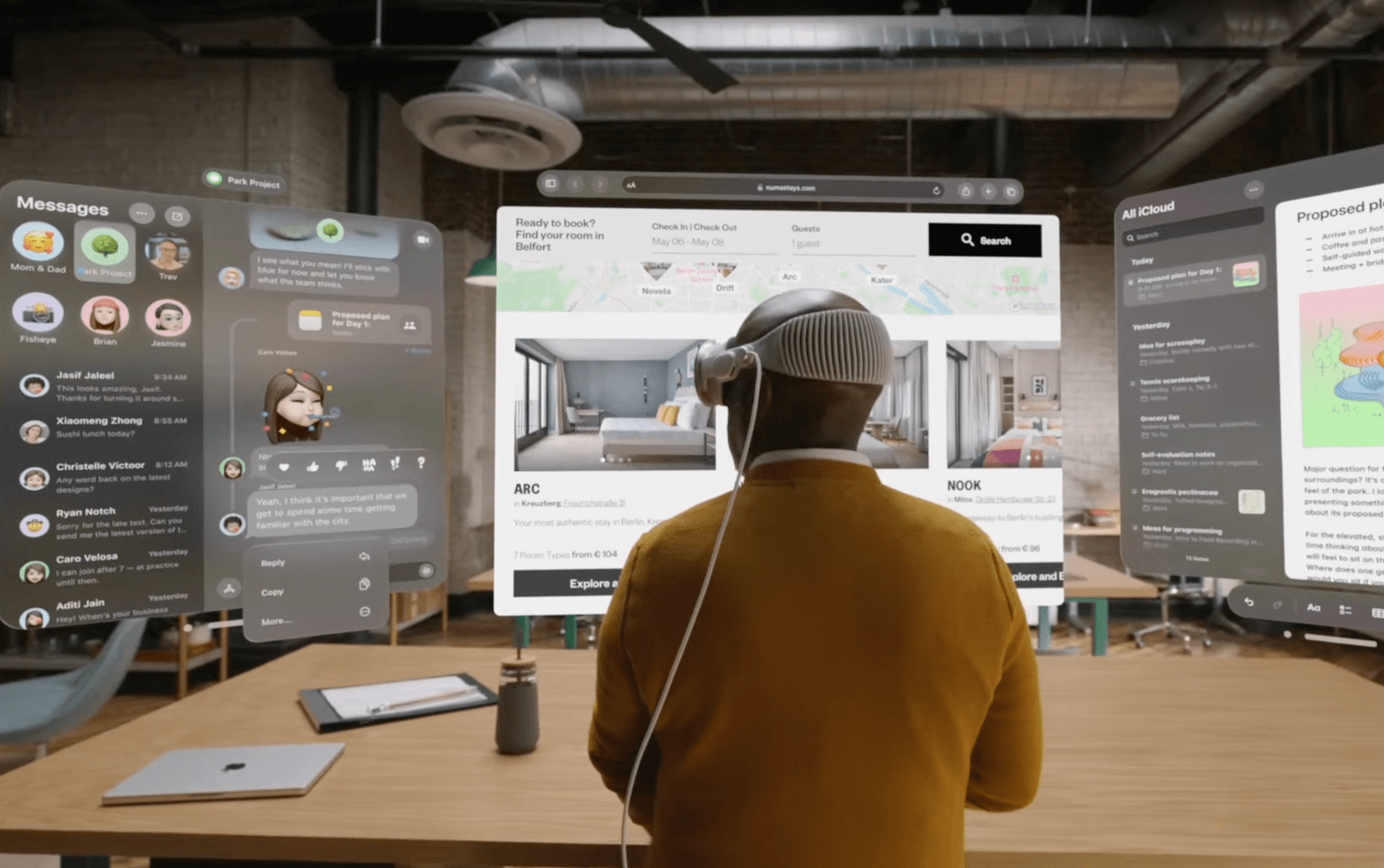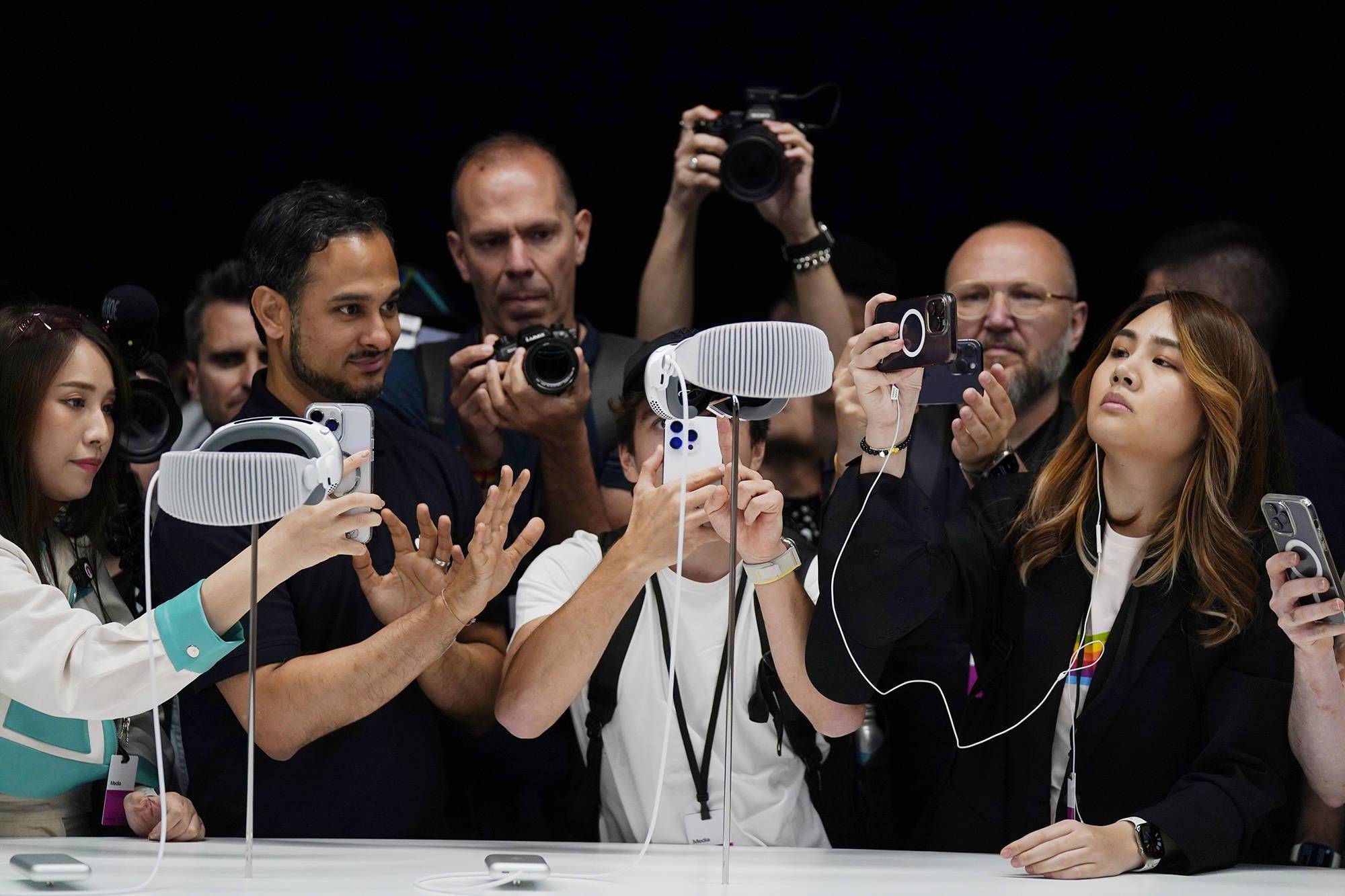 Technology peripherals
Technology peripherals
 AI
AI
 When the VR/AR industry cheers for Apple, what are they cheering for?
When the VR/AR industry cheers for Apple, what are they cheering for?
When the VR/AR industry cheers for Apple, what are they cheering for?
Apple’s headset is finally here, it’s called Apple Vision Pro.
Since 2018, rumors about this mysterious headset device have never stopped. Every few months, Apple will seek solutions in the upstream supply chain, and news of product verification will break out, implying that the product is on the way, but every time it ends up with a "delay", until today.
This is the first time Apple has launched a new computing platform since the release of Apple Watch in 2014. Everyone is full of expectations. Users, developers, and even industry competitors are the same. After all, in Apple's nearly half-century history of entrepreneurship, every time it creates a new hardware paradigm, it has opened up huge market increments.

Apple Vision Pro is Apple’s most epoch-making hardware in the Tim Cook era|Reuters
But this time, things get a little more subtle. On the one hand, Apple Vision Pro has the industry's top hardware specifications and parameters, which will most likely bring the experience of the head-mounted display device to a whole new level; on the other hand, the price of US$3,499 (approximately RMB 25,000) is also destined to It will not be quickly distributed and popularized like the iPhone.
As Apple’s first product in the head-mounted display category, the symbolic significance of Apple Vision Pro is far greater than the revenue generated by actual sales. It not only anchors users’ cognitive expectations, but also raises a banner for developers. It is also an experience benchmark for the entire industry. Regardless of its ultimate success or failure, Apple will bring an earthquake to the VR and AR industries.
Starting today, the history of VR and AR has turned a new page.$3499 “Next Generation Headset”
Apple Vision Pro is equipped with a set of hardware configurations that go beyond conventional.
The first is the resolution. As previously revealed, Apple Vision Pro is equipped with a single-eye super 4K display module, plus a three-piece Pancake lens solution. The total number of pixels of the entire display system is as high as 23 million.
Although this display system has not yet reached the retina level of "single-eye 8K", it is already quite close, surpassing all head-mounted display products currently on the market.

In terms of sensor configuration, Apple also spared no expense. In addition to the 4 built-in cameras for eye tracking, Apple is also equipped with up to 13 sensors on the front panel of the headset, including high-definition cameras and laser sensors, which can capture and sense the environment around the user, providing Apple Vision Pro with Provide complete AR functions.
For many years, Apple has insisted on developing AR (augmented reality) technology, believing that computing devices cannot be completely separated from reality. Including the previous "Metaverse" concept that became popular due to the name change of Meta, Cook has also publicly expressed that he does not believe that VR is the direction of technological evolution.
But currently VR head-mounted related technologies have become mainstream in the industry. Even Apple Vision Pro had to adopt a VR solution and transform it into an AR platform through an external camera.The final result is that the cost of Apple Vision Pro remains high and the pricing is quite astonishing. Previously, some media compiled the supply chain quotation of Apple Vision Pro and found that the cost of parts and materials alone exceeded US$1,500, with the final price of US$3,499. It was initially only sold in the United States, which destined Apple Vision Pro to have a strong "testing water" "nature.
It can be said that even though it has been officially released, within 1-2 years, Apple Vision Pro still will not immediately enter the lives of most ordinary people. Most consumers, especially domestic users, will not buy this generation of products.
It has been previously reported that Apple’s sales target for Apple Vision Pro in the first year of its release is set at 1 million units. This sales target can be said to be very conservative for Apple. For reference, when the first-generation Apple Watch was released, the number of pre-orders on the first day alone exceeded 1 million.

But considering the overall size of the VR/AR market, this 1 million sales target can be said to be ambitious. After all, the total global shipments of VR/AR headsets in 2022 will be only 8.8 million units. If Apple can successfully sell 1 million Apple Vision Pro units, it means that it can capture about 10% of the market share.
Considering that Apple will almost certainly launch next-generation products with lower prices and for a wider audience in the future, if it can achieve first-year sales of 1 million, this will be a very good start.
What is certain is that the development roadmap of Apple Vision Pro will be longer than any previous Apple product. This is a true "next generation" headset, and most ordinary users may have to wait a long time before they can actually use it.
"Raise the flag" for developers
Apple Vision Pro will not be officially available to the public until next spring, and will initially be available only in the United States.
However, Apple still chose to release Vision Pro half a year in advance at WWDC. The reason behind this is on the one hand to release it in advance to prevent the product from leaking during mass production. Another important consideration is also the "development ecology". Apple It is necessary to lay out in advance and raise a flag for developers.
In the current demonstration of Apple Vision Pro, most of the applications are "Vision versions" of iPhone, iPad, and Mac applications. They just project flat apps into space and hang them up. The problems they actually solve are: There is no difference from the native iOS and macOS App.
As for the Vision App that is truly native to visionOS and built with spatial models, it still requires third-party developers to use their imagination to create it.
Including the specific usage scenarios of Apple Vision Pro, Apple has not made a very clear definition, but has shown relatively broadly that it can run iPhone, iPad, Mac apps, display 3D photos and videos, and can cover home entertainment and productivity offices. , communication and collaboration and many other scenarios.

In the video of Apple Vision Pro, the usage scene is still a "3D" version of the 2D application|Apple
In Apple's demonstration, Vision Pro can be used as a mobile phone, tablet, computer, TV and other computing devices at the same time. But how to go beyond these traditional computing devices and provide unique experiences is still something that developers need to explore.
It can be said that this time Apple Vision Pro smells like a "development kit" inside and out. Not only is it released at WWDC, not only is the price high, but also it is unusually not equipped with a built-in battery. The entire product is powered by an external battery, which has only 2 hours of battery life when disconnected from the power supply.
After the press conference, some iOS developers believed that the Apple Vision Pro released this time was almost a development version of hardware for the development team to develop and debug at their desks, so it did not have a built-in battery. The Vision App developed by developers on this generation of products will run on the next generation of products in the future. There is a high probability that subsequent products will optimize the lightweight design, eventually achieve built-in batteries, reduce prices, and target a broader consumer market.
No one knows for sure Apple’s true intentions. The only thing that is certain is that with Apple’s promotion, the entire XR development ecosystem will be given a shot in the arm.
The "Age of Discovery" in the VR and AR industries
As the giant ship of Apple enters the water, the entire VR and AR industry will usher in the "Age of Discovery."
In the past few years, a major development dilemma faced by the VR and AR industries is that few companies can devote enough resources to break through the ceiling of VR and AR technology, products, and development ecology. That’s why Qualcomm’s Snapdragon XR chips have been slow to iterate, the pace of Meta Quest updates has slowed down, and global VR and AR headset shipments have declined in 2022.
Now Apple’s entry means competition, but also brings more opportunities.
In the past few decades, every time Apple entered a new product category, it almost always brought huge market growth. From the iPhone turning into a smartphone, the iPad turning into a tablet, to the Apple Watch turning into a watch bracelet, and AirPods turning into TWS earphones... While Apple is leading the industry, it has also opened the door to many opportunities.
Including the way and logic of product definition, Apple Vision Pro has also formed some tacit understanding and consensus with many companies in the industry. For example, Apple has also adopted the Pancake design previously used on Quest Pro and PICO 4 in the lens design. And the previous mainstream product definition method in the industry was to make VR headsets, but now both the PICO 4 series products and the Quest 3 just released by Meta have adopted a similar solution to Apple, that is, configuring a camera on the front panel to explore The product form of MR "combines reality and reality".

On-site media bee pupa shooting Apple Vision Pro display machine|AP
For all VR and AR companies, especially those relatively small startups, the market benefits brought by Apple far outweigh the competitive pressure. The era has just begun.
In addition, it is those pioneers in the industry who provide some lower-priced options for users who want to try VR and AR.
For example, for domestic users, considering that Apple Vision Pro will not be sold in China for at least one year, you can still choose the PICO 4 series at this time, and you can experience a product definition method at a lower price A head-mounted display product that is quite similar to the Apple Vision Pro.
Whether it is the 4K resolution of both eyes, Pancake lenses, or the all-in-one, lightweight design, PICO 4 represents the current first-tier level in the industry, and the content ecosystem is also relatively mature. It has also achieved the first market share in China and the second in the world.
Many people regard the release of Apple Vision Pro as the "iPhone moment" in the field of VR and AR. However, the technology evolution cycle of headsets will be longer than that of smartphones back then.
From this perspective, the most exciting thing about Apple Vision Pro may not be the product itself, but the curtain of the next era that it will open.
The above is the detailed content of When the VR/AR industry cheers for Apple, what are they cheering for?. For more information, please follow other related articles on the PHP Chinese website!

Hot AI Tools

Undresser.AI Undress
AI-powered app for creating realistic nude photos

AI Clothes Remover
Online AI tool for removing clothes from photos.

Undress AI Tool
Undress images for free

Clothoff.io
AI clothes remover

AI Hentai Generator
Generate AI Hentai for free.

Hot Article

Hot Tools

Notepad++7.3.1
Easy-to-use and free code editor

SublimeText3 Chinese version
Chinese version, very easy to use

Zend Studio 13.0.1
Powerful PHP integrated development environment

Dreamweaver CS6
Visual web development tools

SublimeText3 Mac version
God-level code editing software (SublimeText3)

Hot Topics
 1378
1378
 52
52
 I Tried Vibe Coding with Cursor AI and It's Amazing!
Mar 20, 2025 pm 03:34 PM
I Tried Vibe Coding with Cursor AI and It's Amazing!
Mar 20, 2025 pm 03:34 PM
Vibe coding is reshaping the world of software development by letting us create applications using natural language instead of endless lines of code. Inspired by visionaries like Andrej Karpathy, this innovative approach lets dev
 Top 5 GenAI Launches of February 2025: GPT-4.5, Grok-3 & More!
Mar 22, 2025 am 10:58 AM
Top 5 GenAI Launches of February 2025: GPT-4.5, Grok-3 & More!
Mar 22, 2025 am 10:58 AM
February 2025 has been yet another game-changing month for generative AI, bringing us some of the most anticipated model upgrades and groundbreaking new features. From xAI’s Grok 3 and Anthropic’s Claude 3.7 Sonnet, to OpenAI’s G
 How to Use YOLO v12 for Object Detection?
Mar 22, 2025 am 11:07 AM
How to Use YOLO v12 for Object Detection?
Mar 22, 2025 am 11:07 AM
YOLO (You Only Look Once) has been a leading real-time object detection framework, with each iteration improving upon the previous versions. The latest version YOLO v12 introduces advancements that significantly enhance accuracy
 Is ChatGPT 4 O available?
Mar 28, 2025 pm 05:29 PM
Is ChatGPT 4 O available?
Mar 28, 2025 pm 05:29 PM
ChatGPT 4 is currently available and widely used, demonstrating significant improvements in understanding context and generating coherent responses compared to its predecessors like ChatGPT 3.5. Future developments may include more personalized interactions and real-time data processing capabilities, further enhancing its potential for various applications.
 Best AI Art Generators (Free & Paid) for Creative Projects
Apr 02, 2025 pm 06:10 PM
Best AI Art Generators (Free & Paid) for Creative Projects
Apr 02, 2025 pm 06:10 PM
The article reviews top AI art generators, discussing their features, suitability for creative projects, and value. It highlights Midjourney as the best value for professionals and recommends DALL-E 2 for high-quality, customizable art.
 o1 vs GPT-4o: Is OpenAI's New Model Better Than GPT-4o?
Mar 16, 2025 am 11:47 AM
o1 vs GPT-4o: Is OpenAI's New Model Better Than GPT-4o?
Mar 16, 2025 am 11:47 AM
OpenAI's o1: A 12-Day Gift Spree Begins with Their Most Powerful Model Yet December's arrival brings a global slowdown, snowflakes in some parts of the world, but OpenAI is just getting started. Sam Altman and his team are launching a 12-day gift ex
 Google's GenCast: Weather Forecasting With GenCast Mini Demo
Mar 16, 2025 pm 01:46 PM
Google's GenCast: Weather Forecasting With GenCast Mini Demo
Mar 16, 2025 pm 01:46 PM
Google DeepMind's GenCast: A Revolutionary AI for Weather Forecasting Weather forecasting has undergone a dramatic transformation, moving from rudimentary observations to sophisticated AI-powered predictions. Google DeepMind's GenCast, a groundbreak
 Which AI is better than ChatGPT?
Mar 18, 2025 pm 06:05 PM
Which AI is better than ChatGPT?
Mar 18, 2025 pm 06:05 PM
The article discusses AI models surpassing ChatGPT, like LaMDA, LLaMA, and Grok, highlighting their advantages in accuracy, understanding, and industry impact.(159 characters)



